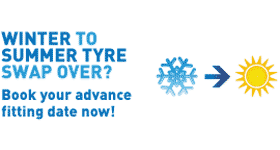How to Check Your Tyres
Checking your Tyres
It should go without saying that your tyres are a fundamental part of your vehicle. They are, after all, the only part of the vehicle that has contact with the road surface. Your tyres may have already saved you and your vehicle from sustaining serious damage or worse many times over.
It's a fact, unfortunately, that they are often poorly maintained and seldom checked - sometimes inspected only during routine servicing or an MOT test.
Checking and maintaining your tyres on a regular basis is relatively straight forward and not particularly time-consuming.
With a few simple tips and explanations we hope to provide you with the knowledge needed to ensure that you achieve the best performance, the maximum wear and of course, the safest possible motoring for you and your family.
So when is the most convenient time to check your tyres?
As a suggestion, why not straight after it has been washed? This way, you will be able to see clearly the sidewalls and surface area (and stay clean!). Soapy water over a tyre will often highlight any punctures too! Otherwise, check your tyres as often as you can but certainly once a month!
There isn't really any better way to check your tyres than to have the road wheel raised from the ground in order to check all areas of the tyre, but we accept that this requires safe lifting equipment and quite a lot of time. You can still carry out a good overall check without going to these measures!
Ok, so you're ready and raring to get checking!
First, grab something you can kneel down on.
Now follow these easy steps:
1. With the handbrake on and out of gear, start your engine (if you have powered steering) and lock the steering fully to one side. Switch off. This will enable you to see fully across the full tread area of the front tyres.
Important: Many modern vehicles have particularly wide tyres. The innermost edge of the tyre can often wear away completely, while the remaining visible part of the tyre surface will appear faultless. Please check carefully - both front and rear.
2. Now check the tread area across the tyre. All tyres have what are called 'tread wear indicators' (TWI) located within the grooves of the surface across the central part of the tread area. These are small raised blocks about 10mm in length and 2mm in height. They're located all around the tyre so you should be able to find them easily enough.
The arrows below point to the TWIs located within the groove of this tyre.

These indicators provide the easiest way to assess the remaining tread depth of your tyre. The minimum depth required is 1.6mm. The indicators rise to 2mm. Therefore, if any part of the tread block area is running flush with the indicators, your tyre has worn to its lowest level. Easy!
3. Assuming there is ample tread left on the tyre, next you need to examine as much of the tread surface as you can. Older tyres and tyres which have stood for some time can suffer from quite severe degradation. Tyres are, after all mostly a natural product!
Examine carefully around the shoulders and within the grooves for signs of cracking and perishing. Sometimes a tyre can wear very unevenly. Your tyre may have perfectly legal tread at one spot and further round the tyre circumference have none so do have a good look.
A tyre that has uneven wear may be distorted. At the same time, look out for any deep and long cuts and any foreign objects (remember your tyres run over all sorts of road conditions and objects and can absorb some of these). You may find bits of stone here and there, and these can usually be prised away without much effort. Anything that will not come out may have penetrated the tyre and be causing a pressure loss (puncture).
4. Now look at the side wall. If you have decorative wheel covers (trims), it is advisable to remove them during checking. It has been found that certain types of trims can cause severe abrasive damage to the side walls - so check for any marks if/where the trim meets the tyre.
The tyre sidewalls are prone to damage from impacts, chafing along curbs, under inflation and tearing. Look for abrasions, cuts or missing rubber. If you can see an abrasion mark running the entire circumference and it has worn away part of the letters and numbers, there's a good chance that the tyre has a puncture or has been run under-inflated for some time! This is caused when the tyre is pinched between the wheel and the road surface (run flat)
By running the flat of your hand over the entire surface of the sidewall, you will be able to detect any bulges (a section where the rubber is protruding from the rest of the wall). Caused by impact, a bulge represents serious damage to the structural integrity of the tyre.
5. Within the outer rim of the wheel, you will find the valve. As much importance should be placed on this component as the tyre itself. If your vehicle has rubber type valves fitted, check for deterioration of the material. By gently moving the valve stem from side to side, look for cracking of the rubber around the base. Ensure that caps are fitted.
6. Repeat this process for each tyre (don't forget the spare) and pay attention to the areas that cannot normally be easily seen.
To re-cap, your vehicle's tyres require attention if you find any of the following faults:
- Low tread depth
- Deterioration of the rubber cracking & perishing
- Uneven tread wear distortion of the tyre
- Deep cuts or sections of tread missing
- Embedded foreign objects
- Side wall damage & bulges
- Damaged/worn valve assembly
Ok, so now you've checked the tyres and valves! While these tips are not exhaustive (believe it or not!), they will give you enough insight to confidently assess the overall condition of your tyres and gain an awareness of when you have a problem.
If all is well, make sure to check the tyre pressures!
If you are in any doubt, please remember that help is just a phone call away on 0333 444 54 54, or complete the QUICK CONTACT form below.








HometyreGroup
Join the conversation
on Twitter
Follow us